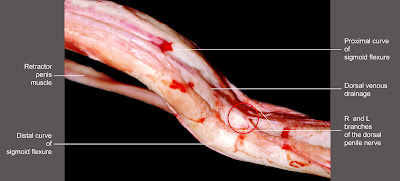Hematoma penis
Keywords: bovine, penis, hematoma. infertility
Rupture of the tunica albuginea of the corpus cavernosum causes hematoma formation where the retractor penis muscles attach to the distal part of the sigmoid flexure. It is common in all beef breeds (most dairy breeds are used for A.I.) but anecdotal data suggests that it may be most common in Herefords. Rupture occurs when the tunica albuginea of the corpus cavernosum is stretched beyond capacity. This is believed to happen if a cow goes down under a bull during service or if the bull lurches forward excessively during copulatory thrusts.
Rupture of the tunica albuginea of the corpus cavernosum causes hematoma formation where the retractor penis muscles attach to the distal part of the sigmoid flexure. It is common in all beef breeds (most dairy breeds are used for A.I.) but anecdotal data suggests that it may be most common in Herefords. Rupture occurs when the tunica albuginea of the corpus cavernosum is stretched beyond capacity. This is believed to happen if a cow goes down under a bull during service or if the bull lurches forward excessively during copulatory thrusts.
1125 x 835 px.
The image above shows a stylized, dissected penile hematoma superimposed on a view of a bull with hematoma penis. Alterations were made by the author to both images and they were then combined. Copyright in both cases is unknown. Please contact Dr Rob Lofstedt (lofstedt@upei.ca) to further identify copyright and permissions.
The dorsal nerve of the penis bifurcates proximal to the sigmoid flexure and as shown below, forms left and right branches over the flexure. The red ring overlying the distal flexure in this image shows the most common site for rupture of the tunica albuginea.
Image size: 2256 x 1022 px
The tear in the tunica can be transverse or oblique. During erection, venous drainage of the corpus cavernosum is occluded and the ischiocavernosus muscles contract, raising the internal pressure in the penis far beyond that of systolic pressure. Using internal pressure transducers, estimates have ranged between about 30lbs/sq inch (~1560 mm Hg) to almost ten times that pressure. Therefore, when rupture occurs, it is not surprising that the dorsal nerves of the penis are often damaged as well. The dorsal nerves provide sensory input from the distal portion of the penis, including the glans penis. Therefore an inability to seek a cow's vulva and penetrate successfully is a common sequel to this injury.
After rupture of the tunica albuginea, large hematomas form in the retropreputial area, causing prolapse of the prepuce with its concomitant problems. Evidence of this can be seen in the top image of this entry. Also, hematomas may become infected, forming abscesses in this area. Therefore antibiotic treatment is essential in these cases. Generally speaking, rupture of the corpus cavernosum carries a guarded prognosis.
Although 30 to 50 percent of bulls may recover with conservative treatment, surgery may allow up to 75 percent to return to service and is recommended when warranted by the value of a bull. That level of success suggests that the dorsal nerves are not severely damaged in most cases or alternatively, they have a remarkable ability to regenerate. Importantly, surgery should be performed soon after injury before adhesions form.
References:
Ashdown, R.R. 2006. Functional, developmental and clinical anatomy of the bovine penis
and prepuce. CAB Reviews: Perspectives in Agriculture. Veterinary Science, Nutrition and Natural Resources 2006 1, No. 021 29pp.
Becket, S.D et al 1974. Corpus cavernosum penis pressure and penile muscle activity in the bull during coitus. Am. J. Vet. Research 35: 761-764
Gnemmi, G. and Lefebvre, R.C. 2009. Ultrasound Imaging of the Bull Reproductive Tract: An Important Field of Expertise for Veterinarians. Vet Clinics N.America: Food Animal Practice. 25:767-79
Hopper, R.M. and Wolfe, D.W. Online 2014 Restorative surgery of the Penis. Bovine Reproduction. Wiley online library.
Lewis, J.E. et al. 1968. Blood pressure within the corpus cavernosum penis of the bull. J.Reprod. Fert. 17:155-156
Roberts, S.J. 1986. Veterinary obstetrics and genital diseases. Infertility in male animals, pp 796-799. Published by the author, S.J. Roberts.


